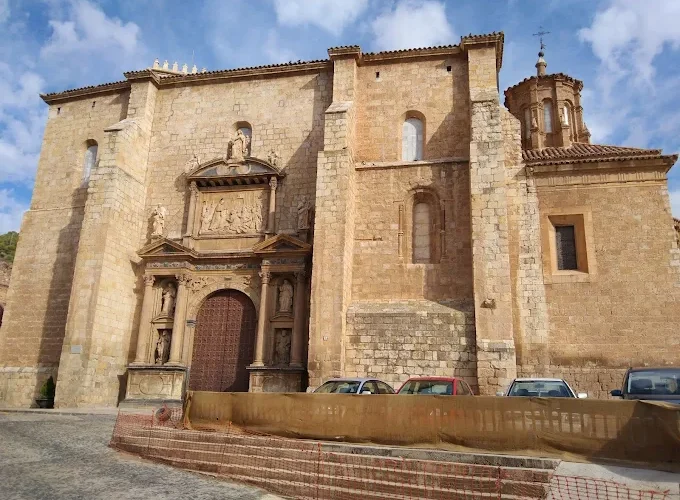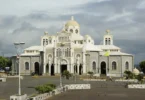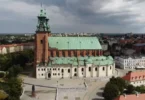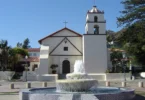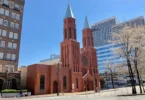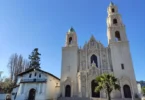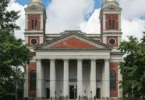Introduction

The Basilica of Santa María de los Sagrados Corporales is a significant Romanesque-style Catholic church located in the historic town of Daroca, in the province of Zaragoza, Spain. Renowned for its architectural grandeur and deep spiritual importance, the basilica stands as one of the most prominent religious landmarks in the region. It is especially revered for its association with the Eucharistic Miracle of the Sacred Corporals an event of profound significance in Catholic tradition. This miraculous occurrence has made the church a vital pilgrimage destination for centuries. In recognition of its religious and historical importance, Pope Leo XIII elevated the church to the rank of basilica on December 3, 1890, further cementing its status as a cherished site within the Catholic faith.

The basilica’s origins trace back to the 12th century, when it was constructed in the Romanesque architectural style. This early medieval style is characterized by massive stone walls, semicircular arches, thick piers, and relatively small windows, giving the structure a fortress-like solidity symbolizing permanence and spiritual introspection. As centuries passed, the church evolved architecturally to reflect changing styles and the growing importance of the site. During the Gothic period (roughly 13th to 15th centuries), the basilica was expanded and ornamented to incorporate vertical emphasis, more abundant natural light, and detailed sculptural decoration. The most prominent Gothic element is the main portal, adorned with intricate sculptures of saints and angels that lend the entrance a dramatic and spiritually evocative character. The Renaissance period brought further transformation, particularly to the church’s interior layout and decoration. A new three-aisled hall plan was introduced, featuring chapels nestled between buttresses, reflecting Renaissance ideals of symmetry, balance, and clarity. This phase introduced elegant architectural elements like fluted columns, Corinthian capitals, and richly detailed frescoes depicting biblical scenes, balancing grandeur with refined aesthetics.
Architecture of Basilica of St. Mary of the Sacred Corporals, Daroca, Spain

Architectural style : Hall church, Romanesque architecture.
External Architectural Features
The basilica’s exterior reveals a complex tapestry of architectural styles layered over centuries. Unlike many Aragonese churches traditionally built in brick, this basilica predominantly employs stone masonry, with finely polished ashlar blocks marking later construction phases. Differences in stone color and weathering highlight the transitions from Romanesque to Gothic and Renaissance periods. The original Romanesque apse remains a key visual element, notable for its semicircular shape, trio of rose windows, and Daroca-style cornicing — a decorative frieze of small arches above modillions (ornamental brackets). The apse also features Romanesque windows with slender columns on the jambs and sturdy buttresses supporting the structure. The church’s tower displays Romanesque origins in its lower cubic section, likely built by the same craftsmen responsible for the original walls. Its upper section is Gothic, distinguished by primitive Gothic windows, battlements, and gargoyles positioned on corners, lending it a distinctive medieval character.

Gateways and Entrances
Gate of Forgiveness (Puerta del Perdón)
Originally the church’s main entrance, now relegated to a side position after Renaissance renovations, the Gate of Forgiveness functioned as a “locus apellationis” — a place where legal appeals could be lodged. This is symbolized by a nail embedded in the door’s garnish. The Gothic-style portal is marked by a segmented arch with restored moldings. Its tympanum uniquely depicts a Last Judgement scene focusing on Christ, the Virgin Mary, and Saint John, surrounded by angels bearing symbols of Christ’s Passion. The sculptural style shows clear influence from 14th-century French Gothic art, notably in its imaginative, expressive figures. Local folklore tells of a swarm of bees that accompanied the Sacred Corporals to the church and nested within the door’s moldings — their descendants are said to still inhabit the site, adding a layer of mystique to the portal’s history.
Renaissance Main Door
The basilica’s current main entrance was created during the late Renaissance expansion, positioned at the foot of the central nave. This entrance showcases classical purist elements with Baroque touches, including striking white and black stone inlays. Architectural features include a semicircular arch supported by simply molded pilasters, flanked by paired Corinthian columns set upon pilasters, and adorned with angelic and vegetal motifs. The entrance is crowned by a large relief depicting the Sacred Corporals, framed by slender columns and vegetal volutes, and topped with a curved pediment featuring a central Virgin image flanked by angels holding shields. Beneath the portal’s arcosolium lie statues of saints on twin plinths, underscoring the basilica’s sacred significance.
Interior Architecture and Design

Inside, the basilica reflects a harmonious blend of Romanesque, Gothic, and Renaissance architectural elements. The original Romanesque apse with its rose windows softly illuminates the interior space. The Gothic influence is found in the ribbed vaults and the Chapel of the Corporals’ vaulting, decorated with thistle pendants and angelic figures. The Renaissance style dominates the overall spatial arrangement with its three-aisled hall plan, narrow side naves, and wide central nave. Pilasters with elegant bases formed by baquetones and bulls on plinths support bundles of four columns with simple yet refined capitals, displaying a classical restraint that balances decorative richness. Vaulting includes star-shaped cross vaults typical of the Plateresque style. A dome was constructed over the central transept, supported by splayed, fluted squinches and decorated with coffered ceilings inspired by Mudejar traditions. This dome culminates in a small square cupola opening into an octagonal structure, further enhancing the interplay of architectural styles.
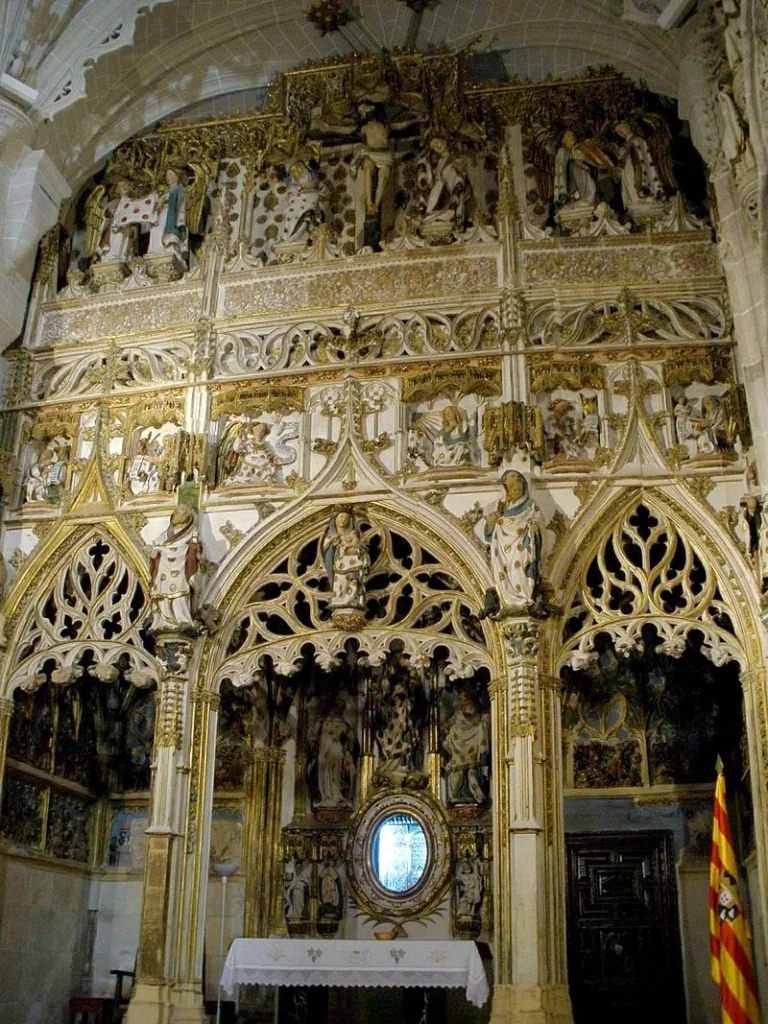
Chapel of the Corporals
The Chapel of the Corporals is the basilica’s spiritual and artistic centerpiece, situated in the original main chapel within the preserved Romanesque apse. This space was transformed from its semicircular plan into a square chamber by adding an openwork wall that accommodates a reliquary altarpiece displaying the sacred Corporals relics. The chapel’s ribbed Gothic vault, adorned with lavish thistle pendants and angel figurines, overlays the original Romanesque vault, creating a striking fusion of styles. Decorative elements throughout the chapel display Flamboyant Gothic and Baroque influences, featuring sculptural groups and tracery recalling the Franco-Flemish jubé style.
The front wall resembles an elaborate altarpiece with three Gothic arches filled with intricate Flamboyant tracery. The central arch features a Virgin Mary holding the Child Jesus, flanked by sculpted prophets under richly carved canopies. Spandrels between the arches and pilasters display reliefs of the Evangelists and the Annunciation. A prominent crucifixion group dominates the intermediate zone, depicting massive, dynamic figures reminiscent of the Burgundian sculptor Claus Sluter’s style. Angels flank the scene, presenting the Sacred Corporals relics to the faithful. Within the alcove, the small Corporals altarpiece features a sculpted predella with figures of virgins and saints. Baroque-era gilding highlights the relic chamber with doors flanking the main image of the Blessed Virgin Mary and Child, possibly accompanied by Saint Catherine. The chapel’s walls carry reliefs narrating the Corporals’ history.
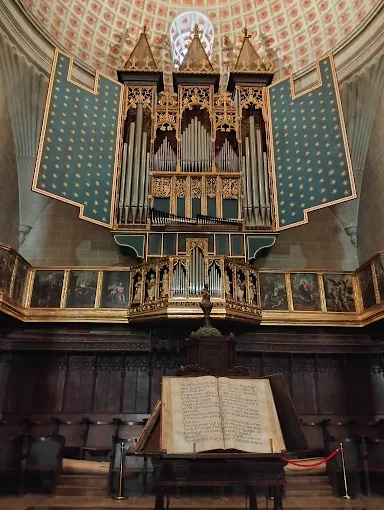
Artistic Attribution and Decorative Elements
The chapel’s complex sculptural program suggests the involvement of at least three different artistic “hands,” reflecting varying styles and influences. The front and altarpiece appear to be by one master, the chapel’s sides by another, and the alcove reliefs by a third, showcasing a spectrum of Gothic and Franco-Flemish elements. Juan de la Huerta, a Daroca-born sculptor who worked in Dijon alongside Claus Sluter, is widely believed to be the principal artist behind the chapel’s decoration. His cosmopolitan experience explains the exotic Burgundian and Franco-Flemish stylistic features, which are unusual in Spain. The chapel’s richly carved sphinxes with Jewish facial features further attest to its unique artistic character. The chapel also retains extensive remains of antique tilework from various periods, adding to its historical and visual richness.
Religious and Cultural Significance of the Corporals
The basilica’s fame centers on the Sacred Corporals, relics connected to a Eucharistic miracle dated to the 13th century. According to tradition, during a battle near Luchente, Christian knights celebrated Mass while surrounded by Muslim forces. The consecrated hosts in the corporal miraculously turned into blood, inspiring the building of the Chapel of the Corporals to safeguard these holy relics. Since then, the relics have profoundly influenced Daroca’s religious, social, and economic life. The city evolved into a pilgrimage center, attracting countless visitors seeking spiritual blessing and miracles. This pilgrimage-driven economy led to the establishment of institutions such as the Corporals Museum, which houses precious goldsmith works, sculptures, paintings, and elaborate vestments associated with the relics. The Most Holy Corporals Brotherhood, founded in 1494, continues to care for the relics and organize religious celebrations such as the Corpus Christi procession, underscoring the relics’ ongoing spiritual importance. Daroca’s experience mirrors that of other European cities whose prominence rose through the possession of sacred relics, such as the Chalice of Doña Urraca in León and the Hair of the Virgin in Medina del Campo, both attracting pilgrims and enhancing local cultural identity.
Feast Day
Feast Day : June 3 to June 11
The Basilica of St. Mary of the Sacred Corporals in Daroca, Spain, celebrates its feast during the Corpus Christi festival. The main celebrations and the commemoration of the Eucharistic Miracle take place from June 3 to June 11, with Corpus Christi itself falling on the Thursday after Trinity Sunday (June 19 in 2025).
Church Mass Timing
Sunday : 11:30 am
Church Opening Time:
Monday to Sunday : 5:30 pm – 7:30 pm
Tuesday to Friday : 11:00 am – 1:00 pm., 5:30 pm – 7:30 pm
Sunday : 11:00 am – 1:00 pm
Contact Info
Address : Basilica of St. Mary of the Sacred Corporals
Pl. España, 7, 50360 Daroca, Zaragoza, Spain
Phone : +34 689 94 27 27
Accommodations
Connectivities
Airway
Basilica of St. Mary of the Sacred Corporals, Daroca, Spain, to Zaragoza Airport (ZAZ), distance 59 min (90.8 km) via A-23.
Railway
Basilica of St. Mary of the Sacred Corporals, Daroca, Spain, to Terrace Rincón de Goya 50006 Zaragoza, distance between 1 hr 4 min (86.0 km) via A-23.

